Tips On Archery Shooting And Hacks
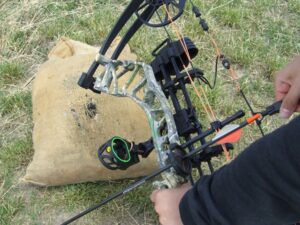
Archery can be great fun and the more you learn with some tricks and hacks can make archery more enjoyable. So here are over 45 tips on archery shooting and hacks for bowhunting, field and target archery.
Use bowstring wax on field points to stop them rattling.
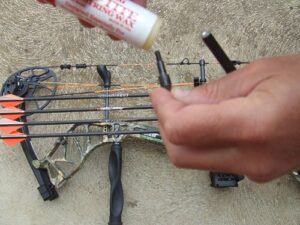
If your screw in field points or broadheads rattle on the arrows, place some bowstring wax on the screw in thread. This will stop the rattle and also can be used for loose bow sights and bow quiver mount screws as well.
You can also use Teflon tape, but the bowstring wax is more convenient.
Take pictures.
If you change the draw length of a compound bow take a photo or video of the original way the module and screws are positioned first. So when you put the new draw length modules or screws back on you know exactly where they go and which way.
(I have done this for fixing faucets as well when taking them apart.)
Use your hat as a work mat in the field.
If you have to work on your equipment in the field, such as on bow sights or release aid devices, use your hat to place underneath to catch any small screws that fall out.
If you don’t place something down, a small screw might fall out and may get lost forever in the foliage and leaves.
A back pack or spare jacket laid out on the ground can also help catch the loose screws and springs.
Balancing the bowhunting bow.
If you like using a bow quiver, but don’t like the way the bow quiver sticks out to the side too much and unbalances the bow, try a closer fitting bow quiver like the TightSpot bow quiver.
This my favorite quiver and is very adjustable and high quality. You can check out the price on Amazon (Affiliate link.) by clicking on TightSpot bow quiver.
Blank bale practice.
Blank bale is probably one of the best additional practice you can do for your archery form.
It doesn’t matter if you are a target shooter, Olympic style archer, barebow shooter, or compound bowhunter, blank bale can help with consistency and shot cycle.
For blank bale practice, you basically have a large backstop target. You don’t have a paper face target on it, the backstop target is blank. You stand close to the target, around 6 feet away and just release one, two or three arrows.
The whole idea is you don’t aim, but work on the shot cycle or form.
Some of the best archers in all shooting disciplines practice blank bale. Some archers work on one aspect at a time, such as bow hand placement, back expansion or aiming, etc.
Rod Jenkins in Master of The Barebow DVD series, has excellent information on blank bale practice.
Stop the bowstring untwisting.
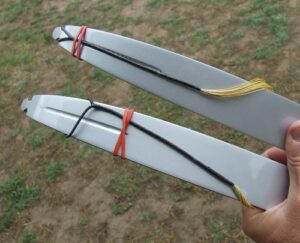
For recurve and longbow archers, to stop the bowstring untwisting when you unstring the bow, slide the top bowstring loop down the limb. Rather than completely take it off the limb. This will stop the bowstring from untwisting.
Most top bowstring loops will generally be larger for this purpose. The bottom loop is smaller.
You can use an elastic band to put over the string loops to hold it in place further.
Test before fletching all the arrows.
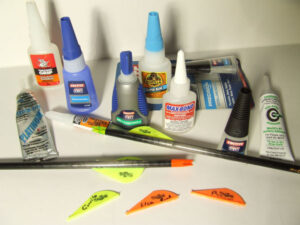
Before you glue on the plastic vanes or feathers on all 12 arrow shafts at once, first do one test arrow.
It can be a bit embarrassing at the archery range to shoot your arrows and eventually one by one, the vanes fall off the arrow shafts. It has happened to plenty of archers who didn’t test their glue. (And me.)
Not all glues work well on everything and one glue designed to stick to a certain brand vane, may not work on another plastic vane. Think of all the combinations and different brands of carbon shafts, aluminum, wood, arrow wraps, feathers and brands of plastic vanes.
So it is best to glue on some fletching on one arrow to test it. The let it dry until the next day and see if the vanes or feathers are glued on properly.
You can by hand try to pull them off and shoot the arrow and see if the fletching is glued on properly.
Clean the arrow shaft and fletching first with the recommended cleaner. Try not to touch the fletching *foot, or arrow shaft with your hands, as your fingers can have oils on them.
(*The foot is the bottom of the vane or feather that attaches to the arrow shaft.)
Have a spare bowstring.
Have a spare bowstring regardless of bowstring age as you might accidentally cut or damage it.
(A portable bow press for compound bows would also be required. This could be in the vehicle for competitions or bowhunting trips.)
Target archers might have two spare bowstrings already shot in, with nock sets and accessories already installed on it.
Mark the limb bolts.
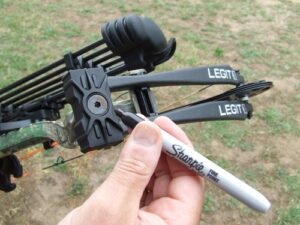
For a compound bow, use a sharpie to mark the limb bolts. This helps you wind them for an even limb tiller.
To ensure they are even for a start, wind the all the way down, (Bow poundage increase.) and then mark the limbs.
Make sure you don’t unwind the limb bolts further out than the manufacture states, or the limbs can dangerously come flying off.
Don’t use super glue for inserts.
Super glue can work for some fletching, but for gluing inserts into the arrow shaft it isn’t ideal.
Super glue dries brittle and can crack when the arrow impacts something hard. The insert can then come out when retrieving the arrow from a firm target.
Also it can set hard before you glue and place the insert in all the way.
It is better to use some glues with some flexible compounds in it like: Bhoning Insert Iron, some BSI type glues, or AAE Max Impact insert Glue.
The good old slow curing epoxy like a two part Araldite glue is also good.
Wax your bowstring.
If you are entering a target archery tournament and you know it is going to rain, wax your bowstring beforehand.
Likewise if you are going bowhunting in wet or extreme dry environments, wax your bowstring before you go.
Click on – How often should you wax your bow string? for more information on how to wax your bowstring and how often.
Silencing your bow for bowhunting gear.
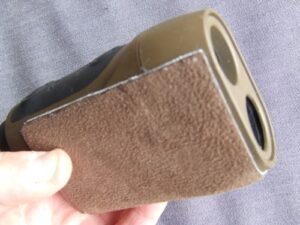
Nothing scares game more than the clang of an arrow on the metal bow riser on a quiet morning bowhunting in the woods. So one solution is to put felt stick on patches on parts of the bow the arrow might accidentally hit or bump and make a noise.
Stick on felt can be used on binoculars and rangefinders as well. This stops the banging and clanging.
Normally I use drab natural colors like brown or green to keep with the camouflage look.
I have also put a small bit on the underside of the bow sight and bow quiver where an arrow might accidentally bump it and make some noise.
The end of a hunting bow stabilizer can easily bump into branches, so I place on the end metal weights.
I have even put some felt strips on the side of the limb pockets, when still hunting so when I put the bow on a log to rest, it didn’t make much noise.
You can also get camouflage stick on fabric tape and thin rubber to stick on.
I must admit I have pimped out a few hunting compound bows with felt patches and it doesn’t look nice. (Especially with a brand new compound.) However it does stop the noise.
I think at one stage it was Martin Archery, (Or Bear Archery?) I can’t remember, but the new bow models at one stage had rubber coating on the compound bow’s shelf and cut out riser where the arrow rest goes. What a great idea!
Camping chair for target archery.
During target archery competitions it can be a long day standing on your feet. So some archers use a camping chair to sit on between breaks.
The chair can also be used to get gear off the ground.
Checklist for target archery.
Target archery competitions can be stressful, so the last thing you want is to forget some items. So have a written checklist, or in your cellphone notes a list of archery gear you need to bring.
Even for bowhunters a checklist can be a good idea, especially if you have to travel a long distance or your hunt is for a several days.
For a recurve Olympic archery checklist, click on – Olympic Archery Equipment List
How do I sight in a bow?
For sighting in your bow remember that the front bow sight will follow where the arrows land on the target.
If the arrows land below the target, adjust your bowsight pins down. This will raise the bow up.
For arrows that land high above your target, raise your pins high and this will lower the bow when aiming.
If your arrows land to the right of your target, move your bow sight pins to the right. This moves your bow to the left when aimed on target again.
For arrows that land to the left of your aiming spot, move the sight pins to the left. This than moves your arrows when shot to the right.
Draw a rough diagram before you head out to sight the bow in, so you remember which way to adjust the bow sight.
Plan for the worst weather.
Most people have been to places where the weather can change in an instant. From hot to pouring rain and cold in a few hours. So even if the weather forecast is fine for your archery tournament or bowhunting trip, plan on the weather changing.
Take clothing that will cater for all conditions in case the weather changes and that you can shoot in. A spare jacket, mid insulation layer and thermals for the cold and rain.
For the heat, take clothing that will protect you from the heat, such as loose long sleeve clothing and wide brim hat.
Test the clothing out, so you can make sure you can shoot in it.
Ensure you can draw back the bow with the extra clothing on and the clothing doesn’t interfere with the bowstring. An armguard might have to be included.
For bowhunters who hunt in remote wilderness areas, these articles might be useful – What should I take in a survival kit? and How to use a compass.
Ditch the rubber tubing peep
For beginner compound bow packages, the bow normally gets fitted out with a peep sight with rubber tubing attached to the cables.
There are some problems with the rubber tubing as it can add weight on the bowstring and pressure, and will eventually wear and break.
It can be a bit time consuming to get the bowstring and peep sight to rotate correctly, but here are a few options for getting rid of the rubber tubing peep sight. Shoot the bowstring in and use good quality bowstrings that will help with aligning the peep sight.
Another possibility is use a peep sight like a tri-peep, which works okay regardless of which way the bowstring is orientated.
Practice not looking.
If bowhunting, practice nocking the arrow without looking at it. Use the arrow nocks with index bumps on them so you can align the fletching the correct way for your arrow rest.
This helps you if you spot game to keep looking at the animal and not look away. If you look away and move, the animal may see you and get spooked.
Setting up the bow.
Use two arrows for setting up a compound bow. Place one arrow shaft on the bows riser to help align the arrow on the arrow rest. Have a secondary arrow on / in the arrow rest.
This gives you a reference point for positioning the arrow rest.
Some compound bow brands have a groove on the shelf which helps indicates the center shot line.
You can also use an arrow to help align it by placing the shaft on the shelf compared to the arrow rest arrows.
Protect your bow.
Don’t leave the bow standing up against anything as it might get knocked over and damaged.
Use a bow case to protect it for travel.
Cams on a compound bow can sometimes get bumped and bent and may dislodge the bowstring off. Or the bump can create a sharp edge which can damage the bowstring and serving. So check your cams now and then, to make sure they are in good condition.
Always use a bow stringer for longbows and recurve bows. As it is safer for the archer and stops the bows limbs from twisting.
Don’t leave your bow in the car on a hot day.
Never dry fire your bow as it can damage the bow. (Releasing the bowstring without an arrow.)
For recurve and longbows, it is normally better to un-string the bow when you are finished shooting.
How sharp should broadheads be?
Although I test the sharpness of the broadheads blades on my forearm hairs to see if they are razor sharp, it can be a bit dangerous.
So a better way is to use paper or rubber bands to see how sharp the broadheads cut them.
Sharpening broadheads.
If you use a wetstone (Whetstone or water stone.) for sharpening broadheads, use a spray bottle with a touch of detergent in it to spray the stone for lubrication.
If you are at a base camp, you can use water from your water bottle or spittle (spit) to help lubricate the wetstone.
Power of the mind.
Never underestimate the value of a confident mindset when competing in archery events. Target, field archery and 3D archers can all benefit form a strong mental game.
Visualization, relaxation methods and meditation can help assist your training regimen to help improve your mind and form to the next level. (And hence your score.)
Understanding Winning Archery by Al Henderson and the Mental Management Systems “With Winning In Mind” audio CD are just two items worth looking into, to help with mindset for archery.
DIY PVC pipe longbow case.
A length of PVC pipe with end caps can be used for a cheap longbow case. Glue one end cap on. Mark the other end with tape or a sharpie, so you know which end to undo.
Use a cut section of an old bed sheet to roll up the longbow in, before you put it in the PVC pipe case to protect it more.
Even a moderate reflex / deflex longbow should fit in the DIY case.
PVC pipe DIY arrow case.
For a cheap arrow case, use the large diameter PVC pipe as well with end caps.
To stop the fletching squashing, cut some foam so it separates the arrows and place in between them.
Novelty moving target.
For a fun novelty shoot, tie a plastic water container with a handle on it with some fishing line attached to a fishing rod.
In a wide safe open place get the archer to wind the fishing rod up. This will move target across the ground and is heaps of fun to try and shoot it.
For safety have physical boundaries or safety marks so the archer doesn’t shoot past a certain point. The person winding up the fishing rod is well behind this point and well out of the way and at a safe angle.
Always safety first.
Bird points.
Make your own snaro type bird points by drilling holes in field tips or blunts. Then use thin wire and make a four loop design wire loops.
Use the bird points with flu flu arrows, so they don’t fly far and you lose them when shooting in the air safely.
Check your local hunting regulations to make sure you are following the small game hunting rules.
Practice distance estimation.
This tip is a good one for practicing for bowhunting and unmarked 3D archery and field shooting. Test yourself by playing a game of seeing how far away an object is from you.
Is it fifteen yards to that tree? Is that fallen branch about 25 yards away? Once you have guessed, double check it with a rangefinder.
Even if you are not in the field, you can practice. Is that letterbox thirty yards away or the house twenty yards away?
I like to break the longer distances down to ten yard increments. As it is easier to first learn ten yards, than it is to learn forty yards by itself.
Even if you use a range finder, test your knowledge of distances.
How do I find my draw length?
For a quick method to find out your draw length, use the arm span method.
Measure your arm span, fingertip to fingertip in inches. Then divide this number by 2.5, this will get you in the ball park for your draw length.
As an example if your wingspan measurement is 70 inches. 70” ÷ 2.5 = 28” draw length.
Remember this is a rough estimation to start from, you might have to adjust ½” or more either way, but the arm span method can get you close to your draw length.
Click on How To Figure Out Your Draw Length which also has a draw length chart and seven methods to easily find your draw length.
For more information on measuring a bow’s draw length, visit How To Measure A Bows Draw Length.
Shorten your draw length.
Most compound bow archers have their draw length way too long. The bowstring should ideally be around your corner of your mouth at full draw. Try this for a few session, shorten your draw length by an inch or half inch and see if your practice scores or paper plate groups are better.
See Correct draw length for more information.
For recurve and longbow shooter’s most beginners will have their draw weight of the bow too heavy. This in turn makes their draw length too short. Swap limbs or try a lighter poundage bow and see if this helps your draw length, consistency and form when aiming.
Arrow fletching tip.
When fletching up arrows, place a drop of glue on both ends of the plastic vanes or feathers.
This helps prevent the fletching coming off when passing through targets.
Arrow falling off the arrow rest?
If you are a beginner archer using a finger release and every time you draw the bow back, does the arrow come off the arrow rest? This is caused by the bowstring fingers pinching the arrow.
Most beginners place the bowstring too far in on their fingers as they struggle with pulling back the bow, as it is a new movement.
Try spacing your string hand fingers a bit wider on the bowstring. Also try a tab with a finger spacing in it.
Make sure your bow poundage is light enough to start with.
Use a Sharpie to mark items.
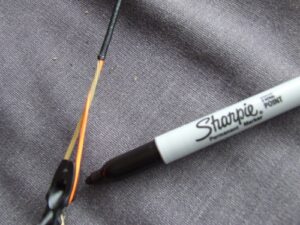
Sometimes when transporting your archery gear or in the field, your peep sight or d-loop can move. (Even if you serve the bowstring above and below the peep. Or have a tied in nock set, with the d-loop.)
So one idea is to mark the bowstring peep sight location with a pen. This mark gives you confidence that no accessories have moved on the bowstring. Or if it has, you can position it back and your bow sights should be spot on.
Use a bow stringer.
Use a bow stringer for safety, ease of use and less stress on the bow.
(I have seen people get whacked in the face when trying to string a recurve. I have heard of archers nearly losing an eye from the limb tip flinging back.)
DIY homemade archery targets.
For an easy homemade DIY target bag, place some old bits of wetsuit material in a burlap or hessian bag. You can’t use it for broadheads, but they work well for field points.
Old bits of rags and cloths also work inside the hessian bag for an archery DIY bag target.
Plastic bags can also be used to stuff inside the bag.
When the old burlap or hessian bag starts getting worn out, just place another bag over it.
Large sugar bags, potato bags and farmer’s grain bags can be used. Bulk pet supply stores or horse feeding supplies might have some secondhand large grain bags that can be used.
Reduce the poundage for beginners.
For beginners practice with a low bow draw weight. Then once you have good form you can increase the bow’s poundage.
Use a broadhead case.
Don’t leave broadheads in the bow quiver when travelling along distance in a bow case. The arrow might vibrate out and damage the bowstring.
To protect the broadhead blades and for safety, use a broadhead case.
Stop broadheads rusting.
After they sharpen their broadheads, some bowhunters put Vaseline on the blades and then put tape over the blades so the edge doesn’t rust or go dull.
Wipe off the coating before bowhunting as the Vaseline can act like a coagulant.
Stop arrows in a back quiver rattling about.
Cut up some small pieces of wetsuit material or foam and place in the bottom of the back quiver. This stops the arrows rattling about and scaring game. This works for both broadheads and field points.
I have heard of archers using oats or rice in the bottom of the quiver, but if it gets wet it would eventually go moldy.
How to get through thick vegetation with a back quiver.
For traditional archery a back quiver has a lot of nostalgia to it, but can be difficult to use going through dense wilderness. One solution when going through the tight places is you rotate the quiver from the back position, to underneath the arm.
With the quiver and arrows horizontally it is easier to go brush and a bit of pressure from the underarm stops the arrows from falling out if they catch some foliage.
Stump shooting practice.
Stump shooting is a great way to hone your field archery or bowhunting skills.
Stump shooting is basically going to the woods or paddock and just picking a target like a small twig or colored leaf that stands out and shoot at it.
Despite the name, stump shooting doesn’t just mean shooting at stumps, although you can do that as well and shoot at old rotted stumps.
Wondering around doing a bit of stump shooting is a great way to spend the afternoon and develop your archery skills in a relaxing environment.
Use judo points, instead of field points, so you don’t lose your arrows. (Or less of them.)
Judo points and small game points and
Field points have a sneaky way of slipping and hiding under grass and foliage and are very hard to find when shot.
Try judo points, types of blunts and small game points for bowhunting small game, or when stump shooting.
Gap shooting tips.
Manipulate the length of the arrow (Don’t cut all your arrow shafts at once, just test and cut one first.) and combine the arrow point weight, to help you get your desired point on distance.
For information on gap shooting and other barebow aiming techniques, click on How To Aim A Bow And Arrow.
This tip can help you when you are first learning gap shooting to help see the arrow tip in your secondary vision. Paint some white on the arrow shaft to help see it. It only has to be about ¼ of an inch or so on the shaft and insert flange.
You can also use liquid paper wite-out from stationary stores. (It will eventually wear off getting shot in targets, but is easy to put on.)
For bowhunting in low light, the white on the end of the arrow shaft can help as well for barebow aiming methods.
Another tip is when the bowstring touches your nose during the expansion at full draw, it can be like a clicker and indicates when you are at proper draw length and you can lose the bowstring. This will depend on anchor position and body characteristics.
Another way is to use the rear of the fletching like a clicker. When it touches your nose at expansion, you release the arrow. Again this will depend on your anchor point. You may have to set your fletching forward on the shaft a bit more than normal.
Fixing loose arrows in the bow quiver.
The grippers on some bow quivers are just too large to hold some small diameter arrows. So one solution is to thread rubber bands into the grippers of the bow quiver. This makes the individual gripper smaller.
Another way is to use small thin patches of stick on felt. It can be a bit fiddly to cut small patches to stick on between the grippers but can work. (Some of mine eventually fell off, but worked for a long time. I couldn’t buy replacement arrow grippers for the quiver as it was a one piece bow quiver I used on a traditional bow.)
This isn’t as good as fix as getting smaller replacement arrow grippers for the bow quiver, but can work on some bow quivers.
Take tools.
If you do go bowhunting, take an Allen key wrench with you so you can tighten loose screws on bow sights, bow quiver mounts, etc.
Murphy’s Law loves archery. The one time I didn’t take an Allen key, I ended up having a loose bow sight.
You don’t have to take a whole tool box in the field, but make sure the tools you take, does fit the size of screws and bolts on the bow and accessories.
Another tip is the night before the trip, is too go over and double check all the bolts, screws and fixtures are tight. Remember to use the first of using bowstring wax to stop screws rattling.
Before bowhunting rap the bows riser with your palm to hear if anything like bow sight, bow quivers, stabilizers are loose. Shake the bow and see if anything rattles and fix it before you go.
Jump up, jump down.
If you are still hunting with a day pack on, to test that you aren’t making any noise, jump up and down to see if anything is rattling. Gorilla tape, bandannas and elastic bands can be very useful in silencing items.
As an example if you have a water bottle that is clanging on the nesting cup items, use a bandana to place in between it to quiet it down. Or perhaps back pack buckles are noisy, so use a bit of tape to cover the metal.
Fix those flat feathers.
If your feathers are looking a bit tattered and lay low, try putting them under some steam to help restore them.
Boil up the kettle and hold the feathers over the steam. Obviously be careful with the hot steam.
Super glue
Some archers place some glue on the d-loop and tie on bowstring silencers, but, don’t place any super glue directly on your bowstring. Because it can dry hard and damage the strands over time when the bundles and strands are being stretched and contracted over time.
I have heard of archers making bowstrings and putting glue on the center serving so it doesn’t unwind, if you make them properly you don’t need to use any glue.
If you do need to put some glue on d-loops of silencers, place the glue on a pin and then place that on the accessories. This prevents you from accidentally putting glue on the bowstring.
Conclusion.
We hope you enjoyed the tips on archery shooting and hacks for bowhunting, field and target archery.
What is your favorite archery tip and tricks?
The bow in some of the photos is the Bear Legit, for a review on it visit – Bear Legit Compound Bow Review.



